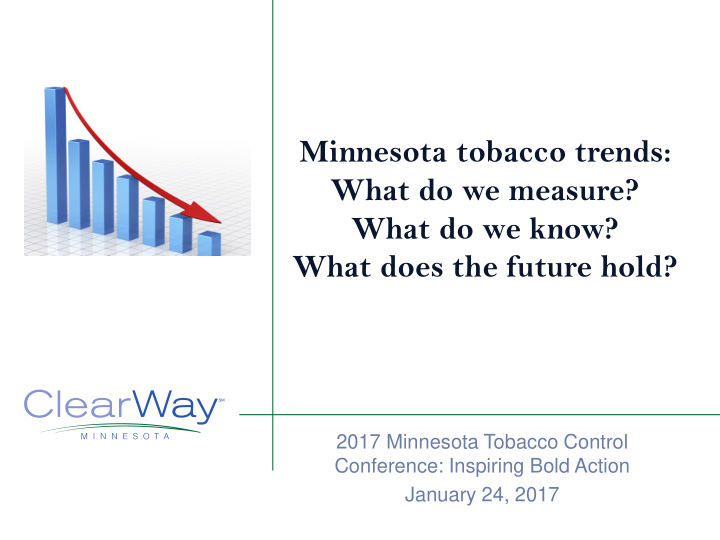



Minnesota tobacco trends: What do we measure? What do we know? What does the future hold? 2017 Minnesota Tobacco Control Conference: Inspiring Bold Action January 24, 2017
Presenters • Barbara Schillo, Ph.D., Vice President ClearWay Minnesota SM - • Pete Rode, M.A., Research Scientist - Minnesota Department of Health • Raymond Boyle, Ph.D., Director of Research Programs ClearWay Minnesota SM - 3
4
• Population-based tobacco surveys in MN: – Nuts and bolts – Strengths and limitations • What have we learned – trends, policy issues, and tobacco-related disparities? • What might future trends look like? Should we set a goal? 5
Population-Based Surveys Uses survey sampling methods to produce data that is representative of the target population of interest 6
Minnesota Adult Tobacco Survey Behavioral Risk Factor Surveillance System Minnesota Youth Tobacco Survey Minnesota Student Survey
Minnesota Adult Tobacco Survey • Random digit dial telephone survey • Sample size 2014 =9,304 adults • Conducted every 3-4 years since 1999 • Comprehensive source of information: - smoking prevalence - secondhand smoke - behaviors, including impacts of policies - attitudes and beliefs • Provides valid scientific data tracking the impact of comprehensive tobacco control efforts in Minnesota • Conducted by ClearWay Minnesota and MDH
9
MATS • No precise estimates for racial/ethnic groups • Provides relevant information for addressing disparities: - 25.1% of Minnesota smokers smoke menthol - Young adults have the highest menthol use rates of any age group at 31.6% 10
Behavioral Risk Factor Surveillance System (BRFSS) • Random digit dial telephone survey • Average sample size 16,000 • Produces estimates annually • Includes smoking but questions limited: - Smoking prevalence - Use of smokeless tobacco • For 2017, four new questions on the use of menthol products • Funded with state and federal funds
12
Can examine association of tobacco use with: • Obesity • Physical activity • Fruit/vegetable consumption • Chronic disease prevalence • Access to healthcare 13
Minnesota Youth Tobacco Survey • Every three years • School-based survey • 2014 N=4,243; 6-12 graders • Strengths: - Conventional and new tobacco products - Secondhand smoke exposure - Attitudes and beliefs - Media exposure • Weaknesses: - Lack of racial-ethnic group results • Conducted by MDH since 2000
Minnesota Student Survey • Every 3 years • Census based • Nearly 127,000 8, 9, and 11 graders 2016 • Strengths: - Excellent source of health equity/demographic data - Can look at links between tobacco use and other health conditions, behaviors and experiences • Weaknesses: - Just a handful of tobacco questions • Conducted by 4 state agencies, including MDH since 1992
Summary Survey Strengths Weaknesses Links • • MATS In depth Lack of racial/ethnic www.mnadulttobaccosurvey.org • Trends estimates • • BRFSS Racial/ethnic estimates Limited questions www.health.state.mn.us/divs/chs/brfss • Associations with other risk factors • Trends (2011) • • MYTS In depth Lack of racial/ethnic www.health.state.mn.us/tobaccodata • Trends estimates • • MSS Racial/ethnic estimates Limited questions www.health.state.mn.us/divs/chs/mss/ • Associations with other behaviors 16
Together they tell our story…. • Detailed technical reports • Fact sheets • News releases • Media coverage • Radio actualities • Presentations and webinars 17
Recommend
More recommend